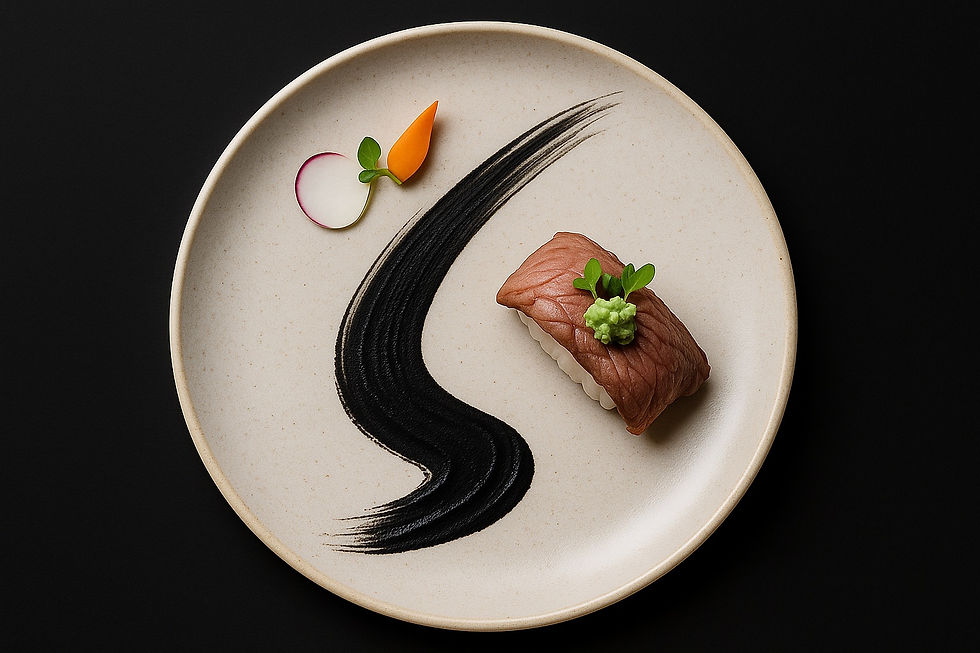The Brush and the Plate: How Japanese Calligraphy Inspires Modern Washoku Presentation
- 清水 芳樹
- 6月21日
- 読了時間: 3分
Discover how Japanese calligraphy shapes the visual elegance of modern Japanese cuisine.

Introduction
In Japan, the culinary experience is far more than the flavors on the tongue—it's a multisensory engagement with philosophy, tradition, and visual art. One of the most subtle yet profound influences on modern Japanese cuisine, especially in its presentation, is Japanese calligraphy, or shodō.
This art of brush and ink, deeply rooted in Japanese culture, has long expressed not just words, but rhythm, emotion, and the beauty of space. Today, its spirit lives on—unexpectedly—on the plate.
The Invisible Thread: Linking Ink and Cuisine
At first glance, the connection between a calligraphy scroll and a dish of sashimi may not be obvious. But look closer. In both, there is a reverence for:
Line and flow
Composition and balance
Negative space (known as ma)
In Japanese calligraphy, the space between strokes speaks volumes. Similarly, in modern washoku, chefs use empty space to create elegance and calm. The layout of the plate isn’t just about aesthetics—it’s about storytelling through contrast and quietude.
This is one of the subtle signatures of Japanese culture: harmony through restraint.
Brushstroke on a Plate: A Contemporary Culinary Aesthetic
Across Michelin-starred kaiseki restaurants in Kyoto, innovative omakase counters in Tokyo, and avant-garde washoku in New York and Paris, the influence of Japanese calligraphy is visible in the way chefs plate their creations.
Examples include:
A single stroke of black sesame sauce brushed across a pristine white dish
Squid ink “sumi-e” effects reminiscent of ink-wash paintings
Glazes applied to grilled fish or wagyu with the motion of a calligrapher’s hand
Minimalist arrangements where visual “pauses” elevate the sense of luxury
These are not mere design choices—they reflect a philosophical lineage. Food becomes calligraphy. The plate becomes the paper.
The Calligraphy of Kaiseki: A Harmony of Traditions
Kaiseki, Japan’s haute cuisine, is perhaps the most literal embodiment of this artistic crossover. Traditionally served in a tea ceremony setting, kaiseki dishes are often presented alongside a calligraphy scroll that expresses the seasonal mood or theme of the meal.
The sequence of dishes unfolds with the grace of brushwork—light to heavy, flowing yet grounded. Hassun (the seasonal course), with its curated visual symmetry, could easily be mistaken for a calligraphy composition. Suimono (clear soup), in its simplicity and stillness, echoes the tranquility of ink on paper.
In this dining tradition, Japanese culture and aesthetics are consumed with the same reverence as the food itself.
Culinary Artists Inspired by the Brush
Modern culinary masters are increasingly open about their reverence for Japanese calligraphy:
“I don’t just plate food. I write with it,” says a Tokyo-based chef at a two-star kaiseki restaurant.
Chefs such as Yoshihiro Narisawa and Zaiyu Hasegawa have publicly acknowledged their use of visual composition inspired by the brush. Their plating reflects spontaneity, control, and intentional imperfection—all values in shodō.
At the luxury level, these chefs do not only aim to please the palate—they aim to evoke emotion, rhythm, and time itself.
This is culinary artistry in dialogue with Japanese culture’s ancient traditions.
Experience It Yourself: Where to Find Washoku with a Calligraphic Touch
For connoisseurs of design, gastronomy, and culture, the following destinations offer a journey through Japan’s living art:
Kikunoi (Kyoto): A Michelin-starred kaiseki haven, where seasonal plates mirror poetry
Den (Tokyo): Avant-garde washoku with unexpected, minimalist beauty
Florilège (Tokyo): French-Japanese fusion where dishes flow like brushwork
Narisawa (Tokyo): Ecology-driven cuisine rooted in aesthetics and philosophy
Beyond Japan, restaurants in Paris, New York, and Singapore are embracing the same aesthetics in high-end Japanese dining.
Conclusion: Seeing with Cultural Eyes
To dine on modern washoku is to witness an elegant intersection of Japanese calligraphy and cuisine. It is a quiet, contemplative experience—where each bite, each brushstroke of sauce, and each space between ingredients tells a story.
For the cultural traveler and the epicurean alike, recognizing these calligraphic influences deepens one’s appreciation not only of the food—but of Japanese culture itself.
Experience authentic Japanese calligraphy: https://calligraphyartwork.stores.jp/



Comments